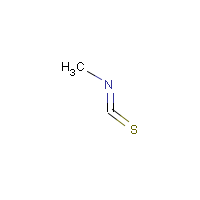Methyl isothiocyanate
Agent Name
Methyl isothiocyanate
CAS Number
556-61-6
Formula
C2-H3-N-S
Major Category
Nitrogen Compounds

Synonyms
Isothiocyanate de methyle [French]; Isothiocyanate de methyle [ISO-French]; Isothiocyanatomethane; Isothiocyanic acid, methyl ester; Isotiocianato de metilo [Spanish]; Isotiocianato di metile [Italian]; MIT; MeNCS; Methane, isothiocyanato-; Methyl isothiocyanate; Methyl mustard; Methyl mustard oil; Methyl-isothiocyanat [German]; Methylisothiocyanaat [Dutch]; Methylisothiocyanaat [Netherlands]; Methylisothiocyanat [Denmark]; Methylisothiokyanat [Czech]; Methylsenfoel [German]; Metile isotiocianato [Italian]; MITC; Morton EP-161E; Trapex; Trapex-40; Trapexide; Vorlex (Nor-Am); Vorlex 201 (Nor-Am); Vortex; WN 12; [ChemIDplus] UN2477
Category
Isothiocyanates
Description
Colorless crystals that sublime at room temperature; mp = 36 deg C; [HSDB] Pale yellow low melting solid with an acrid odor; mp = 30-34 deg C; [Alfa Aesar MSDS]
Sources/Uses
Used as an insecticide and soil fumigant; Possibly used as a chemical weapon; [HSDB] A breakdown product of the soil fumigant metam sodium; [Murray, p. 1830] The primary degradate of metam sodium and metam potassium that is responsible for their soil fumigant properties; Used as an antimicrobial on wood poles and pilings; [Reference #2]
Comments
A strong irritant, vesicant, and lacrimator; Inhalation of high concentrations can cause bronchoconstriction, lung injury, seizures, and coma; [HSDB] May cause second or third degree burns after brief skin contact. [CHRIS] Reacts with water producing carbon dioxide and methylamine; [CAMEO] A strong skin sensitizer in animal studies; [Reference #2] Causes burns; Inhalation may cause corrosive injuries to upper respiratory tract and lungs; May cause skin sensitization and lachrymation; Toxic by ingestion and inhalation; [Alfa Aesar MSDS]
Reference Link #1
Biomedical References
Exposure Assessment
TIH
Yes
Vapor Pressure
3.54 mm Hg
Odor Threshold Low
1.7 ppm
Lethal Concentration
LC50 (rat) = 540 mg/m3
Explanatory Notes
Flash point = 20 deg F; [CAMEO] VP from ChemIDplus;
Reference Link #2
NFPA
may ignite at ambient temp
Adverse Effects
Skin Sensitizer
Yes
Lachrymator
Yes
Toxic Pneumonitis
Yes
Neurotoxin
Other CNS neurotoxin
Dermatotoxin
Skin burns
Diseases, Processes, and Activities Linked to This Agent
Diseases
Occupational diseases associated with exposure to this agent:
Processes
Industrial Processes with risk of exposure: